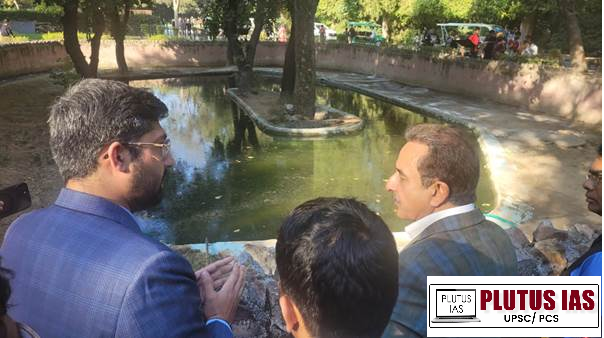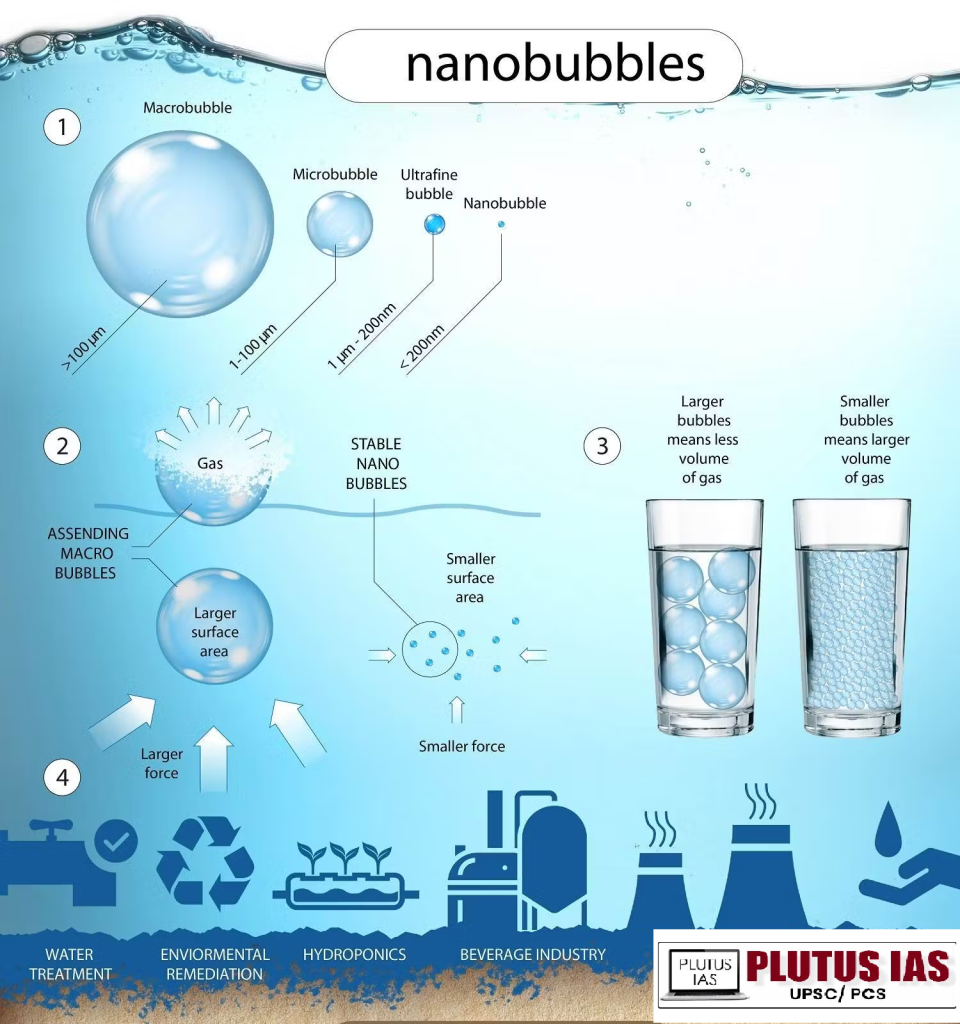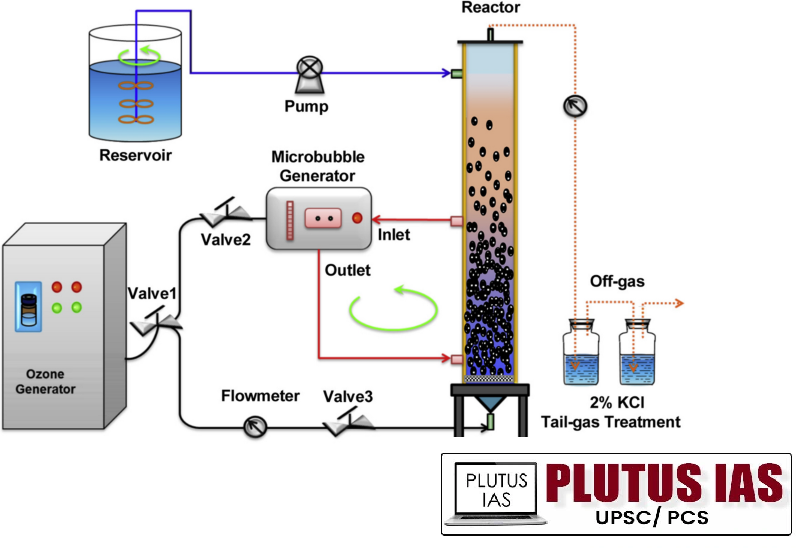20 Dec Unlocking the Power of Nano Bubbles: A Revolution in Technology
SYLLABUS MAPPING:
GS-3-Science and technology-Unlocking the Power of Nano Bubbles: A Revolution in Technology
FOR PRELIMS:
What is nano bubble technology and its applications in various filed?
FOR MAINS:
What are the key features of nano bubble technology and the hurdles in tapping its potential
Why in the news?

What is Nano Bubble Technology?
Key Features of Nano Bubbles:
1. Size: Nanobubbles are incredibly tiny, with a diameter of less than 1 micrometre (1000 nanometers), which allows them to behave differently from larger bubbles.
2. Stability: Unlike larger gas bubbles that rise quickly and dissipate, nanobubbles remain stable in liquid for much longer periods. This makes them highly effective in processes where sustained gas presence is necessary.
3. High Surface Area: Due to their small size, nanobubbles have a high surface area-to-volume ratio. This allows them to interact more efficiently with surrounding liquids, leading to more effective chemical reactions.
4. Unique Behavior: Nanobubbles can stay suspended in liquids without rising to the surface, which is a key feature that distinguishes them from larger bubbles.

Applications of Nano Bubble Technology:
1. Water Treatment: Nanobubbles can enhance water quality by increasing the dissolved oxygen content in water, aiding in the breakdown of contaminants, improving 2. microbial activity, and enhancing the efficiency of water purification processes.
3. Environmental Protection: They help in treating industrial wastewater by increasing oxygenation, which supports the breakdown of pollutants and improves water quality. Nanobubbles are also used in environmental cleanup to remove oils, heavy metals, and other contaminants from water and air.
4. Agriculture: In agriculture, nanobubbles are used to enhance irrigation systems, improving oxygen levels in soil and water, which boosts plant health, root growth, and overall crop yield.
5. Aquaculture: In fish farming and aquaculture, nanobubbles provide a continuous supply of oxygen to fish tanks, improving fish health, growth rates, and survival.
6. Medical and Healthcare: Research is exploring the use of nanobubbles for drug delivery systems, where they can transport medications more effectively to targeted areas in the body.
7. Cleaning and Disinfection: Nanobubbles are used in cleaning processes because of their ability to break down oils, dirt, and other contaminants more effectively, leading to more efficient disinfection
How Nano Bubble Technology Cleans & Purifies Water:
1. Algae Removal: Nanobubbles break down algae and prevent its buildup in stagnant water, improving clarity and preventing harmful blooms.
2. Waste Treatment: They efficiently digest biological waste and separate oils, fats, and grease, accelerating wastewater treatment.
3. Gas Transfer: Nanobubbles enhance oxygen transfer, supporting aerobic microorganisms that break down pollutants and improve water quality.
4. Surface Cleaning: They remove organic materials from surfaces without chemicals, effectively cleaning pipes, tanks, and equipment.
5. Odor Control: Nanobubbles help neutralize odours by breaking down organic compounds responsible for unpleasant smells in water.
6. Enhanced Filtration: They assist in particle removal by agglomerating smaller contaminants, improving water clarity and filtration performance.
7. Disinfection: Ozone-infused nanobubbles disinfect water by killing harmful bacteria, viruses, and pathogens, offering an eco-friendly alternative to chemicals.
8. Heavy Metal Removal: Nanobubbles aid in removing heavy metals like lead and mercury, making water safer for use.

Issues hindering the potential of Nanotechnology:
1. High Production Costs: Creating nanobubbles requires specialized, costly equipment, limiting its affordability for large-scale use.
2. Scalability: Expanding nano bubble applications from small to large systems is challenging and expensive.
3. Lack of Standardization: A lack of consistent methods and protocols makes it difficult to evaluate or replicate results.
4. Limited Long-Term Research: More studies are needed to understand the long-term effects on ecosystems, health, and industry.
5. Regulatory Concerns: Safety and regulatory challenges exist, particularly in food, agriculture, and medical applications.
6. Energy Consumption: Nanobubble generation consumes significant energy, which can reduce environmental benefits if not optimized.
7 . Unclear Mechanisms: The exact interactions of nanobubbles with contaminants or materials are still not fully understood.
8. Equipment & Maintenance: The need for specialized, high-maintenance equipment adds to operational costs.
9. Environmental Variability: Water conditions like temperature or contaminants can reduce the effectiveness of nanobubbles.
Way forward:
1. Reduce Costs: Innovate more cost-effective manufacturing processes and materials to make nanotechnology accessible for widespread use.
2. Enhance Scalability: Focus on developing scalable methods that can be applied in large industries, ensuring efficiency and affordability.
3. Establish Standards: Create global standards and regulations for nanotechnology to ensure consistency, safety, and effective implementation across sectors.
4. Promote Research: Invest in long-term, interdisciplinary research to understand the full capabilities and risks of nanomaterials and their applications. Address
5. Address Regulatory Concerns: Work with governments and regulatory bodies to ensure clear guidelines for safe and responsible use in areas like healthcare and food.
6. Optimize Energy Use: Improve energy efficiency in nanotechnology processes to ensure sustainability and reduce the environmental footprint.
Conclusion:
Prelims Question:
Q. With reference to Nano Bubble Technology, which of the following statements is/are correct?
1. Nanobubbles have a diameter smaller than 1 micrometre, typically ranging from 50 to 200 nanometers
2. Nanobubbles have a very short lifespan and dissipate quickly in liquids.
Select the correct answer using the code given below:
A.1 only
B. 2 only
C. Both 1 and 2
D. Neither 1 nor 2
Answer: A
Mains Question:
Q. Discuss the potential applications and challenges of Nano Bubble Technology in water purification and environmental protection.
(250 words, 15 marks)




No Comments